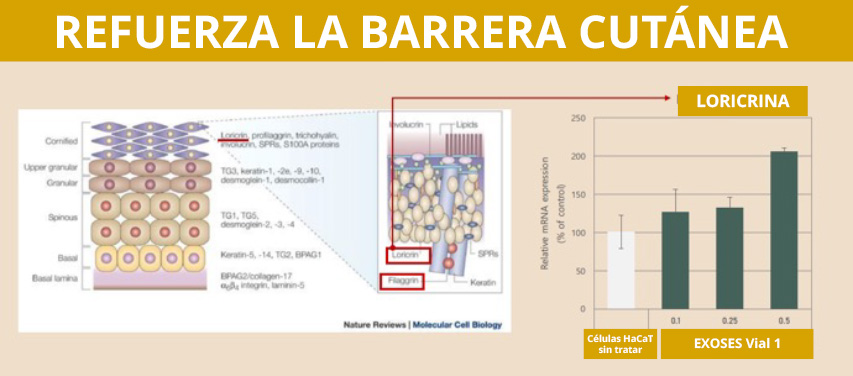PROVEN EFFICACY
LACTOBACILLUS BREVIS EXOSOMES (LCTB): PROBIOTIC MESSENGERS WITH GREAT THERAPEUTIC POTENTIAL
Lactobacillus brevis is a non-pathogenic microorganism that forms part of the skin microbiota or flora. The microbiota is essential to promote the reinforcement of the barrier function, skin regeneration, and protection against external aggressions.
REGENERATES
Increases cellular proliferation of keratinocytes, favoring skin regeneration and restoration.

STRENGTHENS
It significantly increases the expression of filaggrin, loricrin, claudin-1, aquaporin-3, and serine palmitoyl transferase (SPT) proteins involved in the maintenance of the skin barrier function.

SOOTHES
Significantly decreases the expression of pro-inflammatory mediators (IL-6, TNF-A, IL-113 and COX-2), showing an anti-inflammatory effect.

EXOSES LB PROVEN EFFICACY
HIGH ANTI-WRINKLE AND SKIN RE-DENSIFYING POTENTIA

PATIENTS TREATED WITH EXOSES CLAIM*
- 91% BRIGHTER, FINER, and SOFTER skin
- 88% Improves skin FIRMNESS and QUALITY
- 100% Reduces BLEMISHES
- 71% Reduces the size of PORES
- 100% Would recommend and repeat the treatment
*Subjective evaluation of the efficacy of EXOSES LB applied topically after NANOPORE microneedling in 34 volunteers (men and women) with all skin types. Four sessions were performed, spaced every 15 days. Data on file, 2024.
EXOSES LB Vial 1 increases the expression of the filaggrin gene, reinforcing the barrier function of the skin.

Filaggrin is a fundamental structural protein for the development and maintenance of the skin barrier. It is involved in the aggregation and compaction of the intermediate filaments of keratin.
The main function of the skin is to act as a barrier that separates the internal environment from the external environment, protecting from exogenous aggressors and minimizing the loss of water and other fundamental components of the body to the outside. Filaggrin stands out in the development of the skin barrier both for its fundamental role in terminal epidermal differentiation and for its involvement in some of the most frequent dermatological diseases, such as atopic dermatitis (AD) or ichthyosis vulgaris (IV).
Filaggrin deficiency has an important impact on the epidermal barrier. It produces an alteration in the organization of keratin filaments of the cytoskeleton and in the structure of the EC. There is also a decrease in keratohyalin granules, a marked decrease in NHF (and therefore in the hydration of the stratum corneum) and a pH alkalinization.
EXOSES LB Vial 1 increases the expression of the loricrin gene, reinforcing the barrier function of the skin.

Loricrin is the main protein in the cornified covering of keratinocytes in the epidermis and helps keep the skin barrier sealed. Its deficit decreases the barrier function of the skin, making it more vulnerable.
In the stratum granulosum, narrow joints between keratinocytes are formed, which helps to establish a sealed barrier, allowing only the passage of small molecules and ions. Keratinocytes in the stratum granulosum eventually die from a process called cornification, which is different from apoptosis, and become cornified anuclear cells. Cornification involves proteins such as loricrin and involucrin, which form increasing aggregates that end up destroying the nucleus and cellular organelles.
EXOSES LB Vial 1 increases the expression of the claudin-1 gene, reinforcing the barrier function of the skin.

Claudin-1 is the protein needed to prevent the spread of small molecules through the narrow junctions of the epidermis. Its deficit increases trans epidermal water loss, producing dehydration.
Claudins are proteins in the occlusion zone (or “tight junction”) between epithelial and endothelial cells that, together with occludins, allow the formation of paracellular barriers and pores that determine the permeability of the junction.
 Cookie preferences
Cookie preferences

